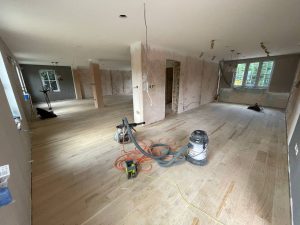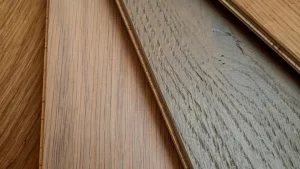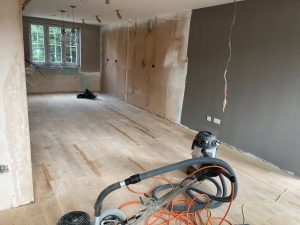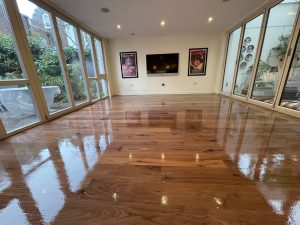
When it comes to choosing the right flooring for your home, understanding the differences between hardwood and engineered wood is crucial, especially when considering the sanding process. Both types of flooring have their own advantages and challenges, but which one is better for sanding? Here’s a comprehensive guide to help you make an informed decision.
- Understanding Hardwood and Engineered Wood
Hardwood Flooring:
- Composition: Made from solid pieces of timber, typically from species like oak, maple, and walnut.
- Durability: Highly durable and can be sanded and refinished multiple times over its lifespan.
- Aesthetic: Offers a natural, classic appearance with unique grain patterns and rich colours.
Engineered Wood Flooring:
- Composition: Consists of a thin layer of real hardwood (veneer) bonded over a plywood or high-density fiberboard (HDF) core.
- Durability: Generally durable, but the thickness of the hardwood layer determines how many times it can be sanded.
- Aesthetic: Designed to mimic the appearance of solid hardwood, available in various finishes and styles.
- Sanding Hardwood Floors

Advantages:
- Multiple Sandings: Hardwood floors can typically be sanded 4-6 times over their lifespan, depending on the thickness of the planks.
- Deep Repairs: Sanding can remove deep scratches, dents, and stains, restoring the floor to its original beauty.
- Long Lifespan: With proper maintenance, hardwood floors can last for decades, even over a century.
Challenges:
- Cost: Hardwood flooring is usually more expensive than engineered wood, both in material and installation costs.
- Labour Intensive: Sanding solid hardwood can be more labor-intensive and time-consuming.
- Sanding Engineered Wood Floors
Advantages:
- Stability: Engineered wood is less susceptible to changes in humidity and temperature, making it a stable option for various environments, including basements and areas with fluctuating moisture levels.
- Cost-Effective: Generally less expensive than hardwood, both in terms of material and installation.
Challenges:
- Limited Sanding: The thin veneer layer means engineered wood can typically only be sanded 1-2 times. If the veneer is too thin (less than 2mm), it might not be suitable for sanding at all.
- Surface Repairs: Deep scratches and dents may not be fully removable if they penetrate the veneer layer.
- Factors to Consider
Floor Thickness:
- Hardwood: Look for thicker planks (5/8” to 3/4”) to maximize the number of times the floor can be sanded.
- Engineered Wood: Ensure the veneer layer is at least 2-4mm thick to allow for future sanding.
Condition of the Floor:
- Wear and Tear: Consider the current state of your floor. Hardwood is better for extensive refinishing, while engineered wood is suitable for minor touch-ups if the veneer is thick enough.
Intended Use:
- High-Traffic Areas: Hardwood may be a better investment for areas with heavy foot traffic due to its ability to be refinished multiple times.
- Moisture-Prone Areas: Engineered wood’s stability makes it a better choice for kitchens, basements, and bathrooms.
Budget:
- Initial Investment: Factor in the cost of materials, installation, and future refinishing. Hardwood has a higher upfront cost but offers longevity.
- Long-Term Maintenance: Consider the long-term maintenance costs. Engineered wood may require replacement sooner if it cannot be sanded.
- Professional Advice
Consult Experts:
- Seek advice from flooring professionals to assess the suitability of your current floors for sanding. They can provide insights based on the specific type and condition of your flooring.
Hire Professionals for Sanding:
- Whether you have hardwood or engineered wood, professional sanding ensures the best results and minimizes the risk of damage.
Conclusion
Both hardwood and engineered wood floors have their own benefits and limitations when it comes to sanding. Hardwood floors offer multiple sanding opportunities and longevity, making them ideal for long-term investments. Engineered wood, while more cost-effective and stable, has limitations on the number of times it can be sanded.
When choosing between hardwood and engineered wood, consider factors like floor thickness, current condition, intended use, and budget. Consulting with flooring experts can help you make the best decision for your London home, ensuring that your floors remain beautiful and functional for years to come. Whether you opt for the timeless elegance of hardwood or the practical benefits of engineered wood, proper maintenance and professional care are key to preserving their beauty.






The Benefits of Refinishing Your Wooden Floors
The Benefits of Refinishing Your Wooden Floors Enhance the Beauty and Value of Your[Read more...]
The Role of Floor Sanding in Property Management
The Role of Floor Sanding in Property Management Introduction Property management involves a wide[Read more...]
Expert Tips for Maintaining Sanded Floors
Sanding your wooden floors can breathe new life into your home, giving it a fresh,[Read more...]
Floor sanding and renovation and installation services in Croydon
Croydon: A Dynamic and Diverse London Borough Croydon is a bustling and diverse borough located[Read more...]
Gallery 06 – Pine floor board
[Read more...]
Sep
Step-by-Step Floor Sanding Process for Beginners
If you’re a homeowner in London looking to rejuvenate your wooden floors, floor sanding can[Read more...]
Wood Floor Reclaiming – Floorboard Replacement
[Read more...]
Gallery 04 – Engineering wooden floor
[Read more...]
Sep
Floor sanding and renovation and installation services in Richmond
Richmond: A Jewel of London’s Green Boroughs Richmond is one of London’s most desirable and[Read more...]
CLT Panels: A Modern Solution for Floor Restoration
CLT Panels: A Modern Solution for Floor Restoration At Alchemist Floor Sanding, we aim[Read more...]